The Tories could be facing the same fate in 2024 as Canada’s federal PCs did in 1993
 The United Kingdom general election will be held on July 4. Prime Minister Rishi Sunak and the Tories appear headed for an electoral defeat of historic proportions.
The United Kingdom general election will be held on July 4. Prime Minister Rishi Sunak and the Tories appear headed for an electoral defeat of historic proportions.
The Tories have been in power since 2010. They currently hold 344 of the 650 seats in the House of Commons. Labour is the official opposition with 205 seats, followed by the Scottish National Party (43 seats), Liberal Democrats (15 seats) and a smattering of other parties and Independents.
Fourteen years of Tory rule and five prime ministers – David Cameron, Theresa May, Boris Johnson, Liz Truss and Sunak – have taken a toll on voters. While the UK has witnessed positive developments, there’s also been political and economic instability, Brexit, “Partygate” and more. Despite Johnson’s 2019 election triumph, the biggest majority since the days of Margaret Thatcher, there is now a strong desire for political change.
The Economist’s rolling election forecast shows Keir Starmer and Labour with a median average of 434 seats, which would be double its current tally. The party’s possible high is 521, which would be the largest majority government in British history. The Tories’ median is 106 seats, although they could achieve a maximum of 202 seats if the votes break in a highly unusual way.
Other polling companies and publications are showing similar results – or worse.
YouGov’s June 19 poll has Labour at 425 seats and the Tories at 108. Electoral Calculus’s June 26 poll has Labour leading the Liberal Democrats by 450 to 71, with the Tories in third place at 60. The Financial Times had Labour ahead of the Tories by 459 to 91 on June 28, while The New Statesman suggested that Labour was leading by 436 to 90 on June 29.
No matter which election projection comes closest to matching the final results, a nightmare scenario for the Tories is almost a given. There are even some suggestions that Sunak could lose his own seat, which is almost unheard of in his country.
Another interesting story has been the rise of Nigel Farage and Reform UK.
Farage is a longtime politician. He was a Member of the European Parliament from 1999 to 2020 and leader of the UK Independence Party and the Brexit Party. He was one of the recognized leaders of the 2016 Brexit movement, which led to Britain leaving the European Union and sank Cameron’s leadership. He’s also been a political broadcaster on GB News, LBC, and Fox News.
Farage retired from politics in 2021 but unexpectedly announced his return on June 3. He gained traction during the election by supporting lower taxes, reforms to the National Health Service and House of Lords, sensible funding increases for public services and introducing proportional representation. Most polls indicate Reform UK will win between two to seven seats, although Electoral Calculus puts them at 18. That’s rather incredible considering they’ve never won a seat in an election – and they’ve only ever held one, which occurred when Conservative MP Lee Anderson crossed the floor in March.
Andrew Neil, chairman of The Spectator and Times Radio host, has suggested Reform UK could either mount a takeover of the Tories post-election or become the dominant right-leaning party. That seems unlikely, but it’s not completely out of the realm of possibility.
Canada’s Conservatives know this all too well.
Brian Mulroney and the Progressive Conservatives won two consecutive majority governments in 1984 and 1988. Although Mulroney largely pursued a fiscally conservative agenda as prime minister, similar to his British counterparts, his popularity waned during an economic recession, constitutional crises with Quebec, and the hated GST. His perceived favouritism toward Ontario and Quebec and inability to address Western grievances also angered conservatives in Alberta, B.C., and Saskatchewan. This anger led to the rise of Preston Manning’s Reform Party. Initially rooted in Western-based populism, it evolved into a nationally recognized right-leaning party.
Mulroney stepped down in 1993. His replacement, Kim Campbell, was a colossal disaster. Her unpolished political demeanour and straight-from-the-hip speaking style were massive liabilities. Her off-the-cuff interviews were even worse, and she became a laughing stock.
The PCs went from 157 seats to two, the biggest electoral collapse of a government in a Western democracy. The party never recovered from this humiliation and became a political rump. Reform won 52 seats, evolved into the Canadian Alliance and got stronger. Conservative supporters shifted to Reform/Alliance in droves,\.
It took time for old wounds to heal on both sides and for new relationships to be built. Stephen Harper’s Canadian Alliance eventually merged with Peter MacKay’s Progressive Conservatives in December 2003. This merger formed the Conservative Party of Canada, and Harper was elected leader in March 2004. After winning the 2006 election, he served as Prime Minister for nearly a decade.
Could Sunak face the same electoral fate in 2024 that Campbell did in 1993? Will Reform UK supersede the Tories like Canada’s Reform Party did to the PCs? We may know better in a few days’ time.
Michael Taube, a Troy Media syndicated columnist and political commentator, was a speechwriter for former Prime Minister Stephen Harper. He holds a master’s degree in comparative politics from the London School of Economics.
For interview requests, click here.
The opinions expressed by our columnists and contributors are theirs alone and do not inherently or expressly reflect the views of our publication.
© Troy Media
Troy Media is an editorial content provider to media outlets and its own hosted community news outlets across Canada.



